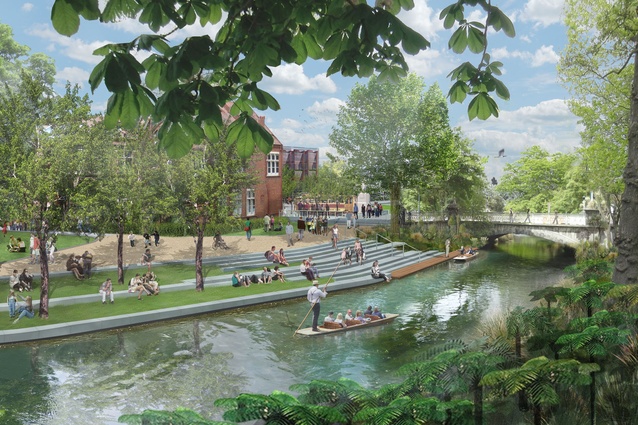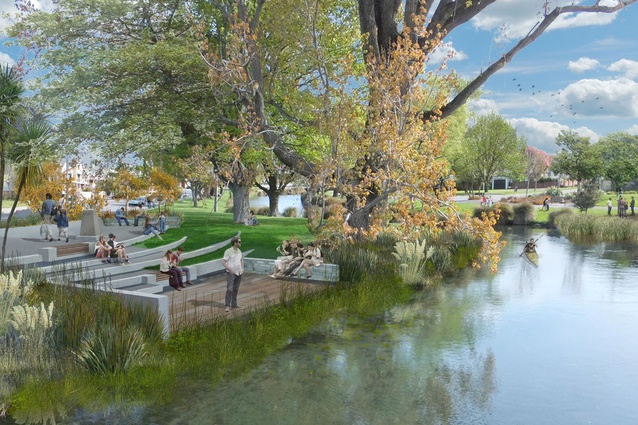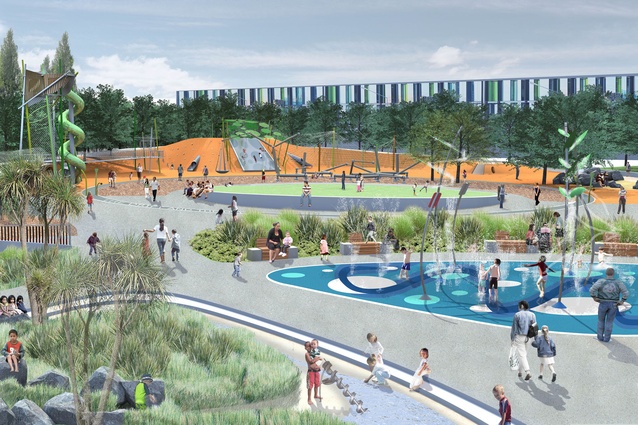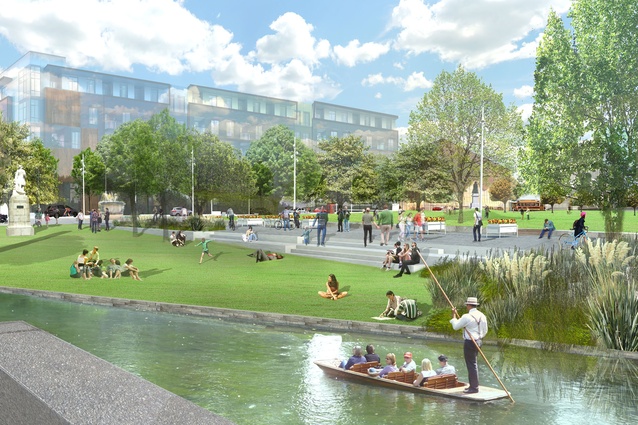A city by the water
The Õtãkaro/Avon River was once the city’s lifeline, a place of kaika, of mahinga kai and mahi kai. It was a commercial vein, an area rich in natural resources, a transport route, and a place where communities lived and traded. In a metaphorical sense, the Õtãkaro/Avon River, as it meanders through Christchurch, is still the city’s lifeline. It is central to Ngãi Tahu and Te Ngãi Tūa-huriri’s connection with the land and underpins their cultural and ecological values. More recently, the Õtãkaro has provided centrality to the city and its identity as a ‘garden city’.
Following the earthquakes, the Õtãkaro has become a core focus of the city’s rebuild. The river itself, its banks, and surrounding streets will form part of the new urban waterfront where development embraces the river, no longer turning its back on this important natural element of the city.
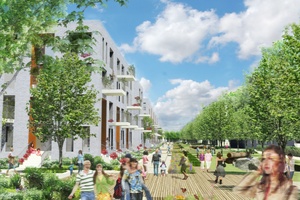
In what is perhaps one of the most ambitious urban regeneration projects of our time in New Zealand, the expansive development of the Avon River Precinct, including the East Frame - a central park that will provide a distinctively landscaped space linking the precinct with the city, has begun. The sheer scale of the project will no doubt shift the way future generations connect and engage with the waterway.
The new Te Papa Õtãkaro/Avon River Precinct will include the river and both sides of its bank, from the Antigua Boatsheds on the edge of the Christchurch Botanic Gardens to Fitzgerald Avenue, and span a 3.2km length of riverbank and approximately 25 hectares of the central business district. The Canterbury Earthquake Recovery Authority enlisted Opus Consultants, with landscape architects from BDP, LandLAB and Boffa Miskell, to design the project, which will be constructed in staged works and ultimately completed by the end of 2015.
The design is based on four overarching principles: a healthy place - a healthy river; a distinctive place - the weaving together of cultures; an accessible place; and, creating a prosperous place. While these principles are diverse in nature, their aims are aligned conceptually with each section of the precinct adhering, albeit with separate focuses, to the four cornerstone principles.
While the first stages of the precinct are not yet complete, a timely installation a stone’s throw from the river provides an interesting perspective about some of the themes that will be incorporated in the rejuvenation of Otakaro. Ngãi Tahu/Samoan artist Lonnie Hutchinson created a 50-metre long installation, which was suspended between Victoria Street’s Arcades Project in July. Significant in that it adds another level of meaning to the Arcades, which had already become something of a landmark amidst the CBD’s changing landscape, the artwork, I Like Your Form, is a giant eel trap or hinaki, and is a grandiose reminder of traditions that may not be immediately apparent in the rebuild.
This notion is one central to the development of the river precinct; the weaving together of cultures combining both Ngãi Tahu and European influences, as well as Pacific and Asian cultural values. “What we are looking to do is build on the sense of place while looking at new values … a layering of identities in the city,” Boffa Miskell landscape architect and project design leadership team member John Potter says. “For Ngãi Tahu, a central aim from the outset was to increase the ability for people to interact with the river. That has really informed our design.”
Opus principal landscape architect Wayne Rimmer says the exotic framework of planting that currently runs along the river will be respected, protected and enhanced as the precinct is developed. “We are making sure the existing mature exotic tree palette is retained and strengthened. But it is also about looking at the pre-European landscape that existed and how we can bring elements of that back into the river precinct. Planting is one layer of detail we are using to enrich the narrative of the place. “We will celebrate the weaving together of the many cultures that have contributed to the landscape character of our city, and celebrate our past and future in this unique place.”
A mix of native and exotic planting will abound throughout the precinct. “The interplay between the two is symbolic of how the whole project fits together”, LandLAB landscape architect and project design leadership team member Henry Crothers says.
The first main section to be completed, The Terraces, will occupy the area in front of what used to be informally known as ‘The Strip’ along Oxford Terrace. Here, a new city promenade will be delivered; a key public realm initiative and shared space where pedestrians will have priority. It will also incorporate the Park of Remembrance and ‘Friendship Corner’, with a series of grassed terraces creating an informal, river’s edge amphitheatre for performances and events. “A significant focus of the overall project has been about changing from a vehicle-dominated streetscape and central city to a pedestrian and cyclist-focused area,” Crothers says.
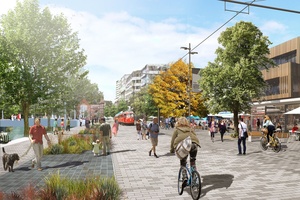
The first section of The Terrace’s new city promenade is scheduled for completion by early 2015. The overall project, made up of seven sections, will incorporate the planting of around 1700 new trees and more than 100,000 shrubs and groundcover plants. While each section has its own distinctive character, heritage and landmarks, the precinct will provide a cohesive feel via the planting, a unifying shared-space, promenade, and a cycleway running the length of the precinct.
In-river works as part of the river rejuvenation project, led by the design teams’ ecologists EOS Ecology, are in line with the guiding principle of ‘a healthy river, a healthy place’. “One of the key in-river themes established from the outset of the project was to improve the aquatic ecosystem through a range of actions including increasing habitat quality and diversity, reinstating a self-cleaning sustainable river system with better land-water, linkages, a continuous riparian zone to improve habitat connectivity, and treating storm water before it enters the river,” EOS’s Shelley McMurtrie says. “The main outcomes of these actions will be to increase habitat complexity, reinstate sections of in-river habitat that have the ability to self-cleanse, reinstate former trout spawning areas that have been abandoned due to sedimentation, and improve habitat connectivity for species migration.”
New opportunities to touch the river, and to travel on and around it with ease, will be delivered. Inviting spaces for exercise and gathering around the waterway will be another focus – part of the aim to create a prosperous place, a new ‘river and city interface – an urban waterfront’ where movement, commerce and recreation converge.
“The primacy of the river in terms of its significance to Christchurch is a key element of the design. It’s about revealing how the city and river can be in dialogue with one another and amplifying that connection between the two,” Crothers says. “We are intentionally blurring the lines between the river and the city.”

